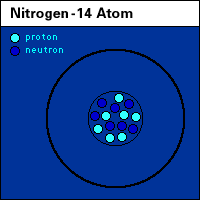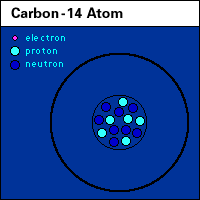
|

|
Close Encounters (of the Cosmic Kind) Back to The Dating Game Right now, in our atmosphere, there are countless numbers of nitrogen atoms floating high above the Earth's surface. These atoms are, in a sense, vulnerable.  Cosmic radiation, in the form of neutrons, zips through the
atmosphere at a high rate of speed. Occasionally, and purely
by chance, some of these neutrons collide with the nuclei of
some of the nitrogen atoms.
Cosmic radiation, in the form of neutrons, zips through the
atmosphere at a high rate of speed. Occasionally, and purely
by chance, some of these neutrons collide with the nuclei of
some of the nitrogen atoms.The nucleus of each nitrogen atom contains seven protons and seven neutrons. That is, it does until a collision happens. The incoming neutron hitting the nucleus causes a proton to shoot out of the nucleus, just as a cue ball on a pool table, hitting one of two balls that are touching, might cause the ball that it hits to stay in place and the other ball to shoot off. The nitrogen atom now has six protons and eight neutrons. This means two things. One, with this arrangement of protons and neutrons, it's unstable. In other words, it's radioactive. And two, it's no longer nitrogen. The reason is that the number of protons an atom contains determines what that atom is. Since it now contains six protons, it's carbon. Carbon usually has six neutrons as well—in this form it's called carbon-12 (6+6=12). The unstable, eight-neutron version, however, is carbon-14 (6+8=14).  All radioactive atoms will eventually decay, or change, in
some way. When a carbon-14 atom decays, one of its eight
neutrons turns into a proton, emitting an electron (with a
charge of -1) in the process. The atom is now stable. And with
seven protons and seven neutrons, it is again nitrogen-14.
All radioactive atoms will eventually decay, or change, in
some way. When a carbon-14 atom decays, one of its eight
neutrons turns into a proton, emitting an electron (with a
charge of -1) in the process. The atom is now stable. And with
seven protons and seven neutrons, it is again nitrogen-14.Next: Eating It and Eating It... Does Race Exist? | Meet Kennewick Man Claims for the Remains | The Dating Game | Resources Transcript | Site Map | Mystery of the First Americans Home Editor's Picks | Previous Sites | Join Us/E-mail | TV/Web Schedule About NOVA | Teachers | Site Map | Shop | Jobs | Search | To print PBS Online | NOVA Online | WGBH © | Updated November 2000 |